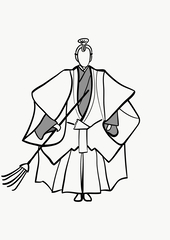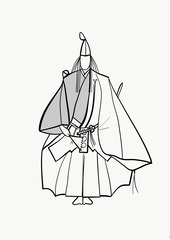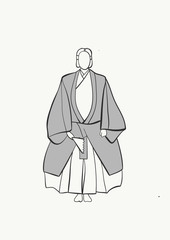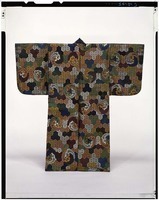Atsuita
あついた 厚板
能狂言
Noh Kyogen
Roles and Draping
Old men in the first half of a noh wear atsuita woven with checks in a dense silk twill as a kitsuke under mizugoromo 水衣, either combined with ōkuchi 大口 (Takasago 『高砂』) or without (Tenko『天鼓』). Warrior courtiers don an atsuita under chōken 長絹 or happi 法被. Old women might drape an atsuita tucked up at the waist (tsuboori) as an outer robe over another kosode garment.



Textile Features and Tailoring
The thick atsuita material is woven with a six-harness twill foundation. The geometric and other designs are rendered in different colored threads woven as supplementary patterning with glossed silk wefts. This patterning technique and the tailoring of the garment are similar to those for the karaori. Atsuita intended exclusively as under garments with only the upper portion partially exposed might be tailored to a three-quarter length.
Designs and Colors
Background patterns are often geometric, such as checks, linked hexagons, concentric diamonds, triangles, or bold zigzag lines. Motifs include Chinese imagery, such as temple gongs, shishi lions among peonies, and dragons in clouds.

Atsuita with design of wisteria rounds over linked hexagons. Edo period. Tokyo National Museum.
http://webarchives.tnm.jp/imgsearch/show/C0016122
Author
Monica Bethe